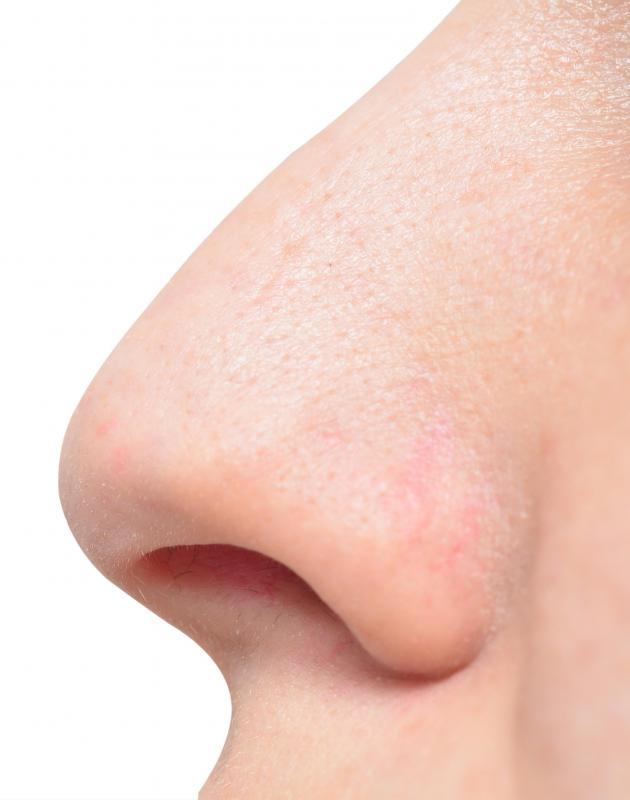At TheHealthBoard, we're committed to delivering accurate, trustworthy information. Our expert-authored content is rigorously fact-checked and sourced from credible authorities. Discover how we uphold the highest standards in providing you with reliable knowledge.
What is Nose Cartilage?
Nose cartilage is tough, flexible connective tissue that forms the tip of the nose. It includes the lateral nasal cartilages, the lesser alar cartilages, the greater alar cartilages, and the septal cartilage. Cartilage is a strong, translucent, elastic tissue that is present in several parts of the body and has no nerves or blood vessels running through it. The tissue in the nose is composed of hyaline cartilage, a slick, rubbery tissue also found in the outer ear, trachea, larynx, and the connections between bones. The shape of these tissues determines the shape of the nose.
Feeling the nose, a person will notice that the upper nose is hard and inflexible until just past the midpoint, when it becomes slightly bendable, though still firm. This change represents the point at which the cartilage begins and the bones end. The top, middle part of the nose consists of two small, rectangular bones called the nasal bones. The sides of the bony section of the nose are formed by the ridges of the maxilla, or the upper jawbone.

Additional bones create the nasal septum, a wall that divides the nose into two passageways. The vomer bone and the perpendicular plate of the ethmoid bone create the greater part of this wall, while the ridge of the maxilla and the palatine bone form the bottom of the septum. Toward the tip of the nose, the nasal septum is composed of cartilage instead of bone. The cartilage of the septum, also called septal cartilage or quadrangular cartilage, connects with the ethmoid bone and the vomer bone at its posterior end, or its rear-most part. The quadrangular cartilage extends almost to the tip of the nose, forming part of the flexible plate that divides the two canals in the nose.

The lateral cartilages are a paired set of triangular tissues that extend like wings from the top of the septal nose cartilage, creating the slope of the sides of the nose. The greater alar cartilages, also called the lower lateral cartilages, are another paired set whose shape determines the appearance of the very tip of the nose. These cartilages form the outside walls of the nose on one side and form a medial, or center, wall on their other sides. The lateral, or side-most, wall of the greater alar cartilage is continuous with the ala of the nose.

The ala of the nose is the soft, flaring portion of flesh that surrounds the nostril. It is composed of mostly fatty, fibrous tissue. Just posterior to this portion and the greater alar cartilages on each side lie the lesser alar cartilages. These paired tissues form the c-shaped indent behind the ala and connect with the maxilla at its posterior end.

Nose cartilage is composed of hyaline cartilage, which consists of living chondrocytes, or cartilage cells, suspended in liquid-filled spaces called lacunae. The lacunae are suspended in a rubbery, collagenous substance called the matrix. Hyaline cartilage is semi-transparent, tough, flexible, and serves several purposes in the body. It often lines joints to reduce friction between bones, supports tubes such as the wind-pipe so that they can stay open, and is instrumental in longitudinal bone growth. The function of this cartilage in the nose is to support the openings of the body part while remaining flexible.
AS FEATURED ON:
AS FEATURED ON:














Discussion Comments
So when someone gets a rhinoplasty they change the septum? I have been always wondering about how do they change the shape of your nose when they say they had a nose job surgery. I was even planning to ask the surgeon about the process of rhinoplasty surgery.
Why is the human nose not made entirely of bone (instead of cartilage)?
If nose cartilage moves after an impact, will it move back?
Can nose cartilage shape be changed with constant pressure?
Yes, an empty nose is a consequence. It's a crime against humans. You have no life, no sleep, pain. How do you live with that? All the techniques are dangerous: turbinectomy, radiofrequency...
Be careful about the nasal cartilage. It is very strong and resistant to reshaping. Nasal cartilage can not be reshaped with pressure. It can be reshaped only by surgery. I bought nasal huggies (Nasal Clip) but after using even for more than a month, there is no change in the shape of my nasal cartilage.
Can the shape of nose cartilage be changed by constant pressure? I have heard of certain products which look like clips, which, when worn over the nose every day for 15 mins, people clam to have changed their shapes of noses without surgery? Is this true? Has anyone a scientific explanation for this theory?
Is nose cartilage composed of the same kind of cartilage as is found in ears, etc? And if they function of the nose cartilage it to hold the holes of the nose open, then how does it work when people have nose cartilage reduction surgeries?
Nose cartilage may not be super hard like the rest of the nose, but let me tell you, you can feel it when you get a nose piercing! My friend got her septum pierced, and she said it hurt terribly, and (this is what would have freaked me out) crunched when they did it!
I don't think I could ever have rhinoplasty or nose cartilage surgery if just getting a piercing is so painful!
One thing commonly associated with nose cartilage is rhinoplasty -- you mentioned the septum; that's the part of the nose that gets reshaped in a nose job. That's why so many celebrities say they had surgery for a "septum deviation". Code language for a nose job. In fact, the difference that you see in those nose job before and after shots is the effects of removing or reshaping the nose cartilage. Unless of course you have too many nose reductions and end up with no cartilage in your nose at all, like Michael Jackson.
Post your comments